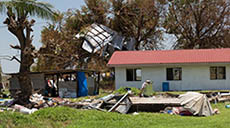How to rebuild post-Cyclone Winston Fiji
Staff and students from Victoria University of Wellington and the University of Auckland will travel to Fiji next month to research how communities can rebuild post-disaster.

Staff and students from Victoria University of Wellington and the University of Auckland will travel to Fiji next month to research how communities can rebuild post-disaster.
Led by Victoria’s Professor Regan Potangaroa, a structural engineer and post-disaster reconstruction expert, the group will visit Fiji for two weeks for research following February’s tropical Cyclone Winston.
Professor Potangaroa has travelled to over twenty countries, including Pakistan, Syria, and Afghanistan, to help in the wake of natural disasters and conflict zones.
In Nadi, Fiji, the group will work alongside a United Nations Shelter Cluster, which is led by the International Federation of Red Cross and Red Crescent Societies. Each member will assist a different response agency in Nadi.
Professor Potangaroa says post-disaster reconstruction is a long and complex process.
“Working in the field is dynamic and ever-changing—it’s very different than what you might see on television or read in the newspaper. It’s important to understand the nature and context of some of the issues around reconstruction.
“Each team member is looking at different things—be it water supply, risk perception, communication, community engagement, marginalisation or quality of life. The idea is that they will work with their agency to observe how things are done, explore the difference between theory and reality, and where possible, make some contribution.”
The group includes Victoria Master’s students Jessica Hulme, Suchita Jain, Anthony Mak and Emily Cayford, and Auckland University PhD students Behrooz Balaei and Harold Aquino from the Centre for Disaster Resilience, Recovery and Reconstruction.
Master of Architecture student Jessica Hulme will be looking at the living conditions of post-disaster communities, to determine what repairs are needed and how post-disaster shelter response can be improved, at a low cost.
“I’m studying Pacific communities that have endured natural disasters, and I hope to assess the role architects could and perhaps should fulfil as design professionals in post-disaster reconstruction.”
Jessica also visited Samoa and Vanuatu last year as part of her project.
The 2009 Samoa earthquake and tsunami ignited her passion for post-disaster reconstruction.
“Being Māori and Samoan myself, I became aware of how agencies are able to help. I was able to respond with my family church in sorting donated goods into shipping containers,” she says.
“Then the Haiti earthquake struck a year later, and I knew I wanted to get involved in shelter response and help in a practical way, so pursued it in my studies. It’s very rewarding work.”
Two other trips involving Victoria architecture researchers are also in the pipeline—Nadrah Ibrahim will travel to Kuala Lumpur to examine how houses become homes in the low cost public housing sector, and Jared Hubbard will visit Banda Aceh in Indonesia to study how older technology can be realised in contemporary design.
